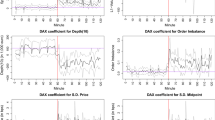Abstract
For a discrete-time super-replication problem, a guaranteed deterministic formulation is considered: the problem is to ensure a complete coverage of contingent claims on an option under all admissible scenarios. These scenarios are specified using a priori defined compact sets, depending on the price prehistory: at each time step the price increments must belong to the corresponding compact sets. The market is considered with trading constraints and without transaction costs. The problem statement is game-theoretic in nature and directly yields the Bellman–Isaacs equations. This paper is focused on several concepts formalizing the no arbitrage property of the market within the deterministic approach as well as on their properties. A new concept of robustness (structural stability) of the no arbitrage properties of the market is introduced.
Similar content being viewed by others
Notes
The price increments are considered backwards, i.e., \(\Delta X_t=X_t-X_{t-1} \), where \(X_t \) denotes the vector of discounted prices at a time step \(t \); the \(i \)th component of this vector represents the unit price of the \(i \)th security.
A risk-free security is supposed to have a constant price equal to 1.
In the sequel, \((\cdot ) \) indicates the variables describing price dynamics. More precisely put, this is the prehistory \(\bar {x}_{t-1}=(x_0,\ldots ,x_{t-1}) \in (\mathbb {R}^n)^t \) for \(K_t \), and the prehistory \(\bar {x}_t=(x_0,\ldots , x_t)\in (\mathbb {R}^n)^{t+1}\) for the functions \(v^*_t \) and \(g_t \) introduced below.
The vector \(h\) describes the positions in the securities, i.e., the \(i\)th component of this vector is the quantity of purchased or sold units of the \(i \)th security.
In an informal economic language, this can be explained as follows, assuming for simplicity that the supremum and infimum in (BI) are achieved. Let \(t\leq N \); the prehistory of discounted prices \(x_1,\ldots ,x_{t-1}\) is known up to the current (present) time step \(t-1 \). For ensuring a complete coverage of contingent claims, first, the value \(V_{t-1}\) of a securities portfolio that hedges the contingent claim on a sold American option must be not smaller than the current contingent claims, which are equal to the potential payments \(g_t(x_1,\ldots ,x_{t-1}) \). Second, the securities portfolio value \(V_t=V_{t-1}+H_t \Delta X_t\) at the next time step must be surely, for any scenario \( \Delta X_t= y\in K_t (x_1,\ldots ,x_{t-1})\) of price fluctuations at the step \(t\), not smaller than \( v^*_t(x_1,\ldots , x_{t-1},x_{t-1}+y)\). (Here the strategy \(H_t \) is formed at the time step \((t-1) \) and may depend only on the price prehistory \(x_1,\ldots ,x_{t-1}.)\) Thereby, for covering the future contingent claims, the securities portfolio value \(V_{t-1}\) for a chosen strategy \(H_t=h\in D_t(x_1,\ldots ,x_{t-1})\) must be not smaller than \( v^*_t(x_1,\ldots , x_{t-1},x_{t-1}+y) -hy\) under the most unfavorable scenario \(y\in K_t (x_1,\ldots ,x_{t-1}) \) of price fluctuations at the time step \(t \), i.e., for the value \(y \in K_t (x_1,\ldots ,x_{t-1}) \) maximizing the expression \(v^*_t(x_1,\ldots , x_{t-1},x_{t-1}+y) -hy\). The resulting value is minimized via choosing an appropriate strategy \(h\in D_t (x_1,\ldots ,x_{t-1}) \), in order to estimate the required reserves for covering the potential future payments. It remains to let \(v^*_t(x_1,\ldots , x_{t-1}) \) be equal to the maximum of the current contingent claims and the value of reserves for covering the potential future payments.
The symbol \(\bigvee \) indicates maximum, and \(hy = \langle h,y\rangle \) is the scalar product of vectors \(h \) and \(y \).
The neighborhoods of the points \(-\infty \) and \(+\infty \) have the form \([\infty , a) \), \(a \in \mathbb {R}\), and \((b, +\infty ]\), \(b \in \mathbb {R} \), respectively.
Under no trading constraints, arbitrage is always associated with unbounded profit, and in this case, no initial capital is required to execute arbitrage.
And not a local martingale, i.e., at each time step the process has a finite mean.
Within the model proposed in [21], the states of the world can be, for example, possible price trajectories of the securities under consideration.
Here, apparently, Merton was referring to dominant portfolios, not just securities.
Unfortunately, the terminology of multivalued analysis in the Russian literature diverges. For example, in the book [4] and paper [3], the term “section” was adopted; the authors [6] preferred speaking about “selection”; in the paper [2], “branch” was considered to be a synonym of “selector”; in the book [7], “branch” was related to multivalued mappings only, and “selector” was comprehended as a choice function for a class of sets (in the sense of set theory).
For example, it is sufficient to require the upper or lower semicontinuity of the multivalued mappings, or their measurability; see \(\S \) 15 and \(\S \) 20 of the book [7].
A stable term has not been established. In this paper, the term “sure arbitrage” is preferred as the most accurate expression for the meaning of this concept. For example, in the book [24], devoted to discrete-time models with a finite number of states of the world (in this case, price increments take a finite number of values), the presence of a dominant strategy (interpreted in a different way than in [23]) is equivalent to sure arbitrage.
According to Carathéodory’s theorem, these points can be chosen in a quantity not greater than \(n+1\), because \(K_t(\cdot ) \subseteq \mathbb {R}^n\).
Strictly speaking, it is correct to consider a cone polar to \(D \) if \(D \) is a cone, some liberty of speech will be accepted here.
Note that compactness for the set \(D_t(\cdot ) \) is not required, as the sets \(K_t(\cdot ) \) are compact.
The notation (3.1) is used here.
The function \(y \mapsto \sup \limits _{h \in D_t(\cdot )} hy=\sigma _{D_t(\cdot )}(y)\) can be \(+\infty \), in the case of the unbounded set \(D_t(\cdot ) \). Here \(\sigma _{D}(\cdot ) \) is the support function of the set \(D \), i.e., \(\sigma _{D}(y)=\sup \{hy:\; h\in D\}\), where \(hy \) indicates the scalar product of the vectors \(h \) and \(y \).
From an economic point of view, this is due to the fact that NDSA expresses a criterion for the existence of a linear pricing rule; for example, see statement (19) in the book [24], where the space of states of the world was assumed to be finite.
Actually, this condition means that a risk-free security, in terms of Merton, is neither dominant nor dominated.
This is possible in the degenerate case, where \(K_t(\cdot )\) belongs to an affine manifold of a dimension smaller than \(n \).
Here \(\textrm {bar}(A) \) indicates the barrier cone of a set \(A \), i.e., \(\textrm {bar}(A)=\{ y \in \mathbb {R}^n: \; \sigma _A(y)<+\infty \}\) .
See \(\S \) 8 in Chapter II of the book [25]. A recession cone for a non-empty convex set \(A\) can be defined as the cone \(O^+A=\{y: \; A+y \subseteq A\}\). If \(A \) is closed, the cone \(O^+A \) will be closed as well.
In particular, if the sets \(D_t(\cdot )\) are compact.
This term was chosen by analogy with the one from the well-known paper [1] published by Andronov and Pontryagin.
This term is used, e.g., in mathematical statistics.
For non-empty sets \(A_1 \) and \(A_2 \), the Pompeiu–Hausdorff distance \(h_\rho \) corresponding to a metric \(\rho \) (in the case under study, \(\rho \) is the Euclidean metric in the space \(\mathbb {R}^n \), i.e., \(\rho (x^1,x^2)=\|x^1 - x^2\|_2 \), where \(\|x\|_2=(\sum \limits _{k=1}^n x_k^2)^{1/2})\), is defined as \(h_\rho (A_1,A_2)=\max (\sup \{\rho (x,A_2),\; x\in A_1\},\; \sup \{\rho (x,A_1),\; x\in A_2 \} ) \), where \(\rho (x,A)=\inf \{\rho (x,y),\; y\in A\}\). This distance can be \(+\infty \). In the class of all non-empty closed and bounded sets of a metrical space, \(h_\rho \) is a metric; see Theorem 5.1 of the book [7].
Here \(\langle h,y \rangle \) indicates the scalar product.
This is equivalent to the following: for \(A \subseteq \mathbb {R}^n \), the hull \(\textrm {aff}(A) \) coincides with the entire space \(\mathbb {R}^n \).
Compact’s Envelope is a convex Body.
Due to the complete dimension of \(K_t(\cdot ) \), the set \(\textrm {conv}(K_t(\cdot )) \) does not belong to the separating hyperplane.
That is, \(zy\geq 0\) for \(y \in \textrm {conv}(K_t(\cdot ))\).
REFERENCES
Andronov, A.A. and Pontryagin, L.S., Robust systems, Dokl. Akad. Nauk SSSR, 1937, vol. 14, no. 5, pp. 247–250.
Blagodatskikh, V.I. and Filippov, A.F., Differential inclusions and optimal control, Tr. Mat. Inst. Steklov, 1985, vol. 169, pp. 194–252.
Borisovich, Yu.G., Gel’man, B.D., Myshkis, A.D., and Obukhovskii, V.V., Multivalued mappings, J. Sov. Math., 1984, vol. 24, pp. 719–791.
Ioffe, A.D. and Tihomirov, V.M., Teoriya ekstremal’nykh zadach (Theory of Extremum Problems), Moscow: Nauka, 1974.
Leichtweiss, K., Konvexe Mengen, Berlin: Springer, 1980. Translated under the title: Vypuklye mnozhestva, Moscow: Nauka, 1985.
Repovsh, D. and Semenov, P.V., E. Michael’s Theory of Continuous Selections. Development and Applications, Rus. Math. Surveys, 1994, vol. 54, no. 6, pp. 49–80.
Polovinkin, E.S., Mnogoznachnyi analiz i differentsial’nye vklyucheniya (Multivalued Analysis and Differential Inclusions), Moscow: Nauka, 2015.
Rokhlin, D.B., A criterion for the nonexistence of the asymptotic free lunch in a finite-dimensional market under convex portfolio constraints and convex transaction costs, Sib. Zh. Ind. Mat., 2002, vol. 5, no. 1(9), pp. 133–144.
Rokhlin, D.B., An extended version of the dalang–morton–willinger theorem under portfolio constraints, Theory of Probability & Its Applications, 2005, vol. 49, no. 3, pp. 429–443.
Smirnov, S.N., A guaranteed deterministic approach to superhedging: the properties of semicontinuity and continuity of the Bellman–Isaacs equations, Mat. Teor. Igr Pril., 2019, vol. 11, no. 4, pp. 87–115.
Shiryaev, A.N., Osnovy stokhasticheskoi finansovoi matematiki, tom 1: Fakty. Modeli (Fundamentals of Stochastic Finance. Vol. 1: Facts, Models), Moscow: Fazis, 1998.
Shiryaev, A.N., Osnovy stokhasticheskoi finansovoi matematiki, tom 2: Teoriya (Fundamentals of Stochastic Finance, Vol. 2: Theory), Moscow: Fazis, 1998.
Cherny, A., General arbitrage pricing model: I-probability approach, in Séminaire de Probabilités XL, Berlin: Springer, 2007, pp. 415–445.
Dana, R.A., Le Van, C., and Magnien, F., On the different notions of arbitrage and existence of equilibrium, J. Econom. Theory, 1999, vol. 87, no. 1, pp. 169–193.
Delbaen, F., Representing martingale measures when asset prices are continuous and bounded, Math. Finance, 1992, vol. 2, no. 2, pp. 107–130.
Delbaen, F. and Schachermayer, W., A general version of the fundamental theorem of asset pricing, Math. Annal., 1994, vol. 300, no. 1, pp. 463–520.
Delbaen, F. and Schachermayer, W., The fundamental theorem of asset pricing for unbounded stochastic processes, Math. Annal., 1998, vol. 312, no. 2, pp. 215–250.
Harrison, J.M. and Kreps, D.M., Martingales and arbitrage in multiperiod securities markets, J. Econom. Theory, 1979, vol. 20, no. 3, pp. 381–408.
Harrison, J.M. and Pliska, S.R., Martingales and stochastic integrals in the theory of continuous trading, Stoch. Process. Their Appl., 1981, vol. 11, no. 3, pp. 215–260.
Jacod, J. and Shiryaev, A.N., Local martingales and the fundamental asset pricing theorems in the discrete-time case, Finance Stochast., 1998, vol. 2, no. 3, pp. 259–273.
Kreps, D.M., Arbitrage and equilibrium in economies with infinitely many commodities, J. Math. Econom., 1981, vol. 8, no. 1, pp. 15–35.
Kneser, H., Sur un theoreme fondamental de la theorie des jeux, CR Acad. Sci. Paris, 1952, vol. 234, pp. 2418–2420.
Merton, R.C., Theory of rational option pricing, Bell J. Econom., 1973, vol. 4, no. 1, pp. 141–183.
Pliska, S.R., Introduction to Mathematical Finance: Discrete Time Models, New York: Wiley, 1997.
Rockafellar, R.T., Convex Analysis, Princeton: Princeton Univ. Press, 1970.
Ross, S.A., A simple approach to the valuation of risky streams, J. Business, 1978, vol. 51, no. 3, pp. 453–475.
Author information
Authors and Affiliations
Corresponding author
Rights and permissions
About this article
Cite this article
Smirnov, S.N. A Guaranteed Deterministic Approach to Superhedging: No Arbitrage Properties of the Market. Autom Remote Control 82, 172–187 (2021). https://doi.org/10.1134/S0005117921010124
Received:
Revised:
Accepted:
Published:
Issue Date:
DOI: https://doi.org/10.1134/S0005117921010124



